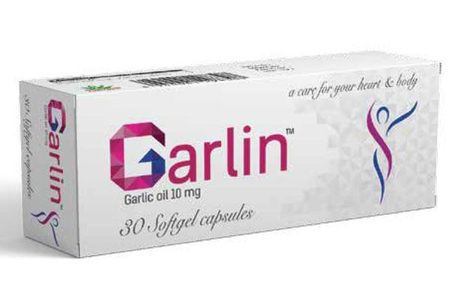Garlin Uses, Dosage, Side Effects and more
The medicinal parts are the whole fresh bulb, the dried bulb and the oil of Garlic. Garlic contains alliin and its transformation products and sulfur containing essential oil. Garlic oil is not present in fresh or dried garlic bulbs, instead the oil is produced by converting water-soluble thiosulfinates to oil-soluble sulfides via steam distillation. Central to Southern Asia is considered the region of origin. Garlic has been harvested in September and October when the leaves and bulbs are dry. In the United States and Western Europe, garlic is one of the most popular substances used to reduce various risks associated with cardiovascular disease. Garlic preparations have been one of the top-selling herbal supplements in the U.S. market for many years.
Garlic reduces total cholesterol (TC), serum triglycerides (TG) and elevates high density lipoproteins (HDL). It prevents platelet aggregation and thrombus formation, stimulates fibrinolysis, prolongs clotting time, reduces low density lipoprotein (LDL) oxidation. It also reduces systolic and diastolic blood pressure and attenuates age and blood pressure related increases in aortic stiffness and reduces blood glucose levels.
Steroid saponins interfere with the absorption of total and LDL cholesterol from the intestinal lumen, thereby reducing plasma cholesterol level without adversely affecting HDL levels.Increases catabolism of fatty acid-containing lipids, especially triglycerides.Enhances palmitate-induced inhibition of cholesterol biosynthesis.Inhibits cholesterol biosynthesis at the level of b-hydroxy-b-methylglutaryl-CoA (HMG-CoA) reductase.The gamma-glutamylcysteines are the compounds in garlic that may lower blood pressure, as indicated by their ability to inhibit angiotensin-converting enzyme in-vitro. Garlic modulates the production and function of both endothelium derived relaxing and constricting factors and this may contribute to its protective effect against hypoxic pulmonary vasoconstriction.Garlic elicits nitric-oxide-dependent relaxation in pulmonary arteries. It increases nitric oxide through activation of nitric oxide synthase activity.Fructans can inhibit adenosine deaminase in isolated cells, thus increasing adenosine and its associated blood vessel dilatory activity

| Attribute | Details |
|---|---|
| Trade Name | Garlin |
| Generic | Garlic Oil |
| Garlic Oil Other Names | Allium Arenarium bulb oil, Allium Controversum bulb oil, Allium Longicuspis bulb oil, Allium Ophioscorodon bulb oil, Allium Pekinense bulb oil, Allium Sativum bulb oil |
| Weight | 10mg, 0.5mg |
| Type | Capsule (liquid Filled), Liquid |
| Groups | Experimental |
| Therapeutic Class | Supplements & adjuvant therapy |
| Manufacturer | Square Pharmaceuticals Ltd, Klar Sehen |
| Available Country | Bangladesh, India |
| Last Updated: | January 7, 2025 at 1:49 am |
Uses
Garlin is used for Hyperlipidemia, Atherosclerosis, Mild Hypertension
Dosage
1 to 2 capsules daily for 8 to 18 weeks or as advised by the physician
How Long Does It Take to Work?
How Long Does It Take to Work? see here Garlin
Side Effects
Gastro-intestinal symptoms, changes to the flora of the intestine and allergic reactions are rare
Interaction
Concurrent use of garlic and antiplatelet agents and anticoagulants might increase the potential for prolonged bleeding. Blood clotting times have been reported to double in patients taking warfarin and garlic suppliments
Pregnancy & Breastfeeding use
None known. Major sulfur containing volatiles from garlic are transmitted to breast milk leading to improved drinking habits of infants
Contraindication
None known. The World Health Organization cautions against the use of garlic by patients with a known allergy to garlic and those taking warfarin
Storage Condition
Store at a cool, dry place and away from direct sunlight. Keep the medicine out of the reach of children



